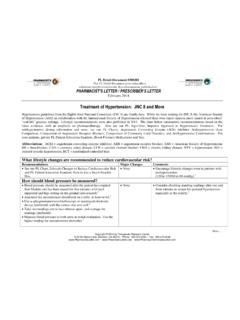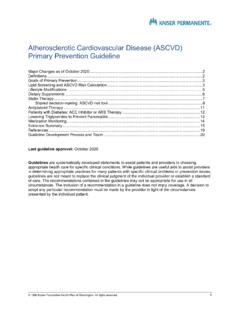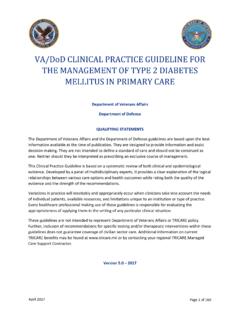Transcription of NICE Guidelines on Pre-Eclampsia
1 NICE Guidelines on Pre-Eclampsia Vikki Barrett Labour Suite Co-ordinator/AMC Link Nottingham University Hospitals NHS Trust 2020 Aim of the session: To give an overview of the latest NICE guidance in relation to hypertensive disorders in pregnancy. Classifications of hypertension Management recommendations Prediction models and PlGF High blood pressure in pregnancy (HDP) Affects 1:10 women 140/90mmHg or more 20% pre-existing (chronic) 80% de novo (gestational/ Pre-Eclampsia ) Chronic hypertension Pre-pregnancy or diagnosed before 20 weeks of pregnancy Associated with adverse maternal and fetal outcomes (stroke, low birth weight, NNU admission) Aim for tight BP control, fetal growth monitoring and repeated assessment for the development of Pre-Eclampsia and maternal complications.
2 Can be managed in an outpatient setting. Consultant led care Stop antihypertensive treatments for women taking ACE inhibitors or ARBs and offer alternatives Labetalol, nifedipine and methyldopa now specified as suitable New guidance on tighter BP target control 135/85mmHg (previously 150/100mmHg) Offer treatment if not already on antihypertensive and BP > 140/90mmHg Offer aspirin 75-150mg OD from 12 weeks Offer PlGF test between 20 week up to 35 weeks if suspected of developing Pre-Eclampsia Lifestyle advice (weight management/exercise/diet/reducing salt intake)
3 Weekly appointments if BP poorly controlled, 2-4 weeks if controlled Timing of birth agreed in partnership if >37 weeks and BP is maintained below 160/110mmHg with or without treatment Gestational hypertension hypertension arising after 20 weeks gestation in the absence of proteinuria and without biochemical or haematological abnormalities. 140/90mmHg-159/109mmHg Severe 160/110mmHg or more Not usually accompanied by fetal growth restriction. Outcomes in pregnancy normally good, but approx 25% will go on to develop PET (particularly if < 34 weeks) and have poorer outcomes Risk factors: P0 Age ( >40) Pregnancy interval more than 10years Family history or previous history of gestational hypertension / Pre-Eclampsia Multiple pregnancy Raised BMI (>35kg/m2) Pre-existing vascular disease Pre-existing kidney disease Management.
4 Watch and wait BP 140-159/90-109mmHg can be managed as an outpatient with once or twice weekly blood pressure measurement and urine dipstick, weekly bloods, PlGF testing and 2-4 weekly ultrasound for fetal assessment. Consider pharmacological treatment if BP remains above 140/90mmHg Labetalol or nifedipine if labetalol unsuitable and methyldopa if labetalol and methyldopa unsuitable Admit if severe (160/110mmHg), but manage as hypertension if falls below Offer treatment and record BP every 15-30minutes until 135/85mmHg. Offer continued pharmacological treatment Daily urine dipstick while inpatient.
5 Measure FBC, U+Es, LFTs at presentation then weekly. Carry out PlGF testing Fetal assessment Timing of birth Do not offer planned early birth before 37 weeks if blood pressure is lower than 160/110mmHg unless there are other medical indications If birth is necessary, offer steroids and Magnesium Sulphate in line with NICE guidance on preterm labour and birth. Outcomes: Watch and Wait 2/10 severe hypertension 47% admission to NNU Treatment 1/10 severe hypertension 23% admission to NNU *Not a uniformly benign condition and risk of complications depends on the gestational age at which it develops.
6 Pre-Eclampsia may develop in 25% of such women. Associated with cardiovascular disease in the long-term Pre-Eclampsia Pre-Eclampsia is a complex medical disorder associated with over 500,000 fetal and neonatal deaths and over 70,000 maternal deaths globally each year. Can deteriorate rapidly and without warning Proteinuria is not mandatory for a diagnosis of Pre-Eclampsia . Rather, this is diagnosed by the presence of new hypertension after 20 weeks gestation accompanied by proteinuria and/or evidence of maternal acute kidney injury, liver dysfunction, neurological features, haemolysis or thrombocytopenia, and/or fetal growth restriction.
7 Pre-Eclampsia may develop or be recognised for the first time intra-partum or early post-partum in some cases. Risk Factors Moderate first pregnancy age 40 years or older pregnancy interval of more than 10 years BMI of 35 kg/m2 or more at first visit family history of Pre-Eclampsia multiple pregnancy. High hypertensive disease during a previous pregnancy chronic kidney disease autoimmune disease such as systemic lupus erythematosus or antiphospholipid type 1 or type 2 diabetes chronic hypertension . Aspirin Women with either 1 high risk factor, or more than 1 moderate risk factor for Pre-Eclampsia , are advised to take 75 mg of aspirin daily from 12 weeks' gestation until the birth of the baby (NICE, 2016).
8 Women with established strong clinical risk factors for Pre-Eclampsia be treated, ideally before 16 weeks but definitely before 20 weeks, with 75 162 mg/day aspirin (ISSHP, 2018) They are also considered for more frequent blood pressure monitoring, and assessment for proteinuria. Women who have significant hypertension (diastolic pressure of 90 110 mmHg) or a proteinuria result of 1+ on urinalysis reagent strips need increased surveillance. Assessment Performed by a HCP trained in the management of hypotensive disorders of pregnancy Concerns include.
9 Sustained systolic BP 160mmHg or higher Abnormalities in biochemical or haematological investigations new and persistent increase in creatinine or fall in platelet count Signs of impending eclampsia Signs of pulmonary oedema (other signs of severe Pre-Eclampsia ) Suspected fetal compromise Consider using fullPIERS or PREP-S validated risk prediction models to guide decision making surrounding appropriate place of care (?need for in utero transfer) and thresholds for intervention. FullPIERS can be used any time in pregnancy PREP-S use only up to 34 weeks Neither predict neonatal outcomes Management of Pre-Eclampsia Timing of birth Record maternal and fetal thresholds for planned early birth before 37 weeks in women with Pre-Eclampsia .
10 Thresholds for considering planned early birth could include (but are not limited to) any of the following known features of severe Pre-Eclampsia : inability to control maternal blood pressure despite using 3 or more classes of antihypertensives in appropriate doses maternal pulse oximetry less than 90% progressive deterioration in liver function, renal function, haemolysis, or platelet count ongoing neurological features, such as severe intractable headache, repeated visual disturbances , eclampsia placental abruption, reversed end-diastolic flow, abnormal CTG or stillbirth.






